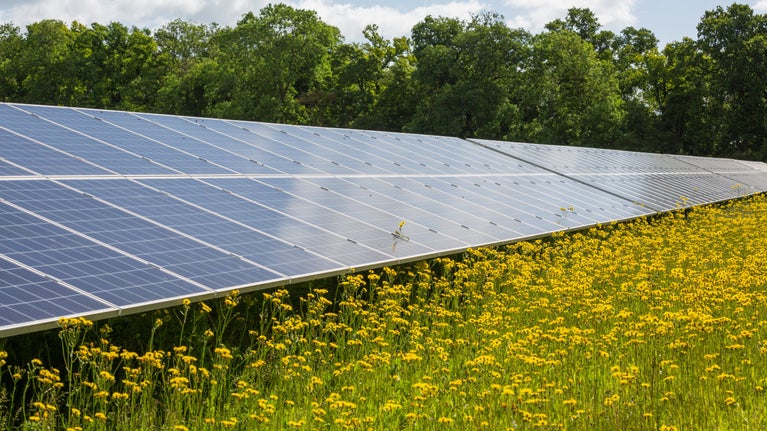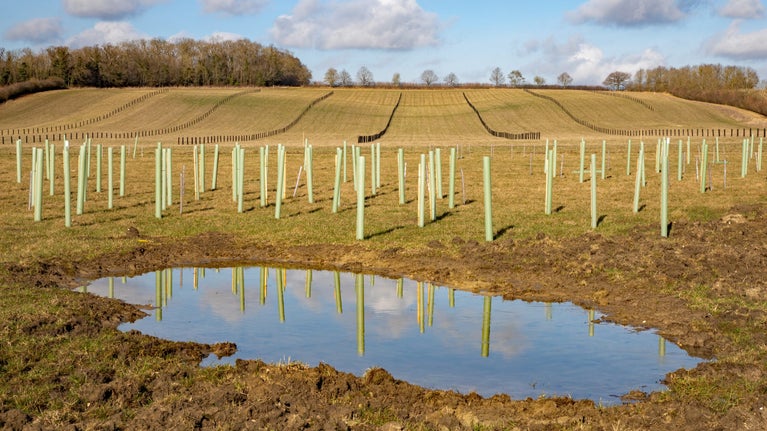Wimpole Estate leads ambition to be carbon net zero by 2030
- Published:
- 13 November 2024
- Last updated:
- 13 November 2024

As world leaders come together at COP29 in Azerbaijan to measure progress and negotiate the best ways to address climate change, Wimpole Estate is making significant savings in net carbon emissions and is one of the leaders in the National Trust’s ambition to become carbon net zero by 2030.
In 2023/24, across the Midlands and East of England region, Wimpole Estate reduced the most number of tonnes of S1&2 carbon (direct emissions, associated with energy and in-hand animals) and was the fifth best property for reduction across the whole of the National Trust.
In only four years, the National Trust has reduced its net carbon emissions at Wimpole Estate from 1,452 tonnes of carbon dioxide equivalent (CO2e) per year to 455 tonnes CO2e, a massive 69% reduction. This CO2 saving would fill Wimpole Hall 779 times and is equivalent to the carbon emitted from 204 homes, heated and powered in the UK each year.
Miranda Campbell, Climate & Environment Adviser for the region, said:
“What the team is doing at Wimpole is a great demonstration of what is possible, delivering a combination of renewable energy and efficiency, and land management, in a cost-effective way that is mindful of heritage, nature and people, as well as improving resilience to current and future climate impacts.”

One of the adaptations that has made the biggest impact at Wimpole Estate is removing an oil-fired heating and hot water system for Wimpole Hall and the Old Rectory Restaurant and installing a ground source heat pump using boreholes and heat exchangers. Reducing the estate’s reliance on fossil fuels has saved around 35,000 litres of oil each year.
Switching to a ground source heat pump system also removes the risk of an environmentally damaging oil leak, reduces costs and significantly reduces carbon emissions. The new system uses less than one-third of the energy used by the old oil boilers, reduces carbon emissions by 47 tonnes per year and saves over £8,000 annually in fuel costs.
The low-temperature background heat provided by a heat pump is also better for the historic collection in the conservation charity’s care at Wimpole, rather than the fluctuating high-temperature heat generated from a fossil fuel boiler.
Wimpole Estate is home to the largest solar installation in the National Trust. Solar Photovoltaic Panels positioned in the car park maximise the harvesting of the sun’s rays throughout the day. A bank of inverters converts the sun’s power into electricity that the National Trust uses to heat and power the visitor welcome building, along with an air source heat pump.
The solar panels provide power for the electric vehicle charging points in the car park, with surplus energy exported to the national grid for use elsewhere. As solar panels continue to work even on a cloudy day, this system is generating electricity for Wimpole Estate 365 days a year. In 2023/24, 344,134kWh of electricity was generated which is enough to meet the electricity needs of 111 average UK homes or two-thirds (67%) of the electricity required by Wimpole Estate.
Wimpole Estate has a sustainable drainage system, enabling runoff water from the estate’s visitor car park to drain through a series of ditches and swales, into ponds. That water is naturally filtered, the silt is removed and can be returned to nature without emitting extra carbon.
Inside Wimpole Hall, the National Trust has reduced energy use by replacing portable radiators with infrared heater panels and in the tallest rooms, ceiling fans have been added, which bring down the heat to where people need it.
Staff and volunteers have been kitted out with heated gilets to wear in cold weather, heating the people rather than the whole space they’re working in. To prevent heat loss from the hall, thick, lined curtains and blinds have been fitted to keep the heat in overnight, which can be used during the day when needed. These are also used in the hotter months to keep rooms cool.
In the café and restaurant, large walk-in fridge freezers have been replaced by more energy efficient technology which has contributed to 42% electricity savings in this area.

Outside, across the 1,000 hectare (2,471 acre) estate, the National Trust has been changing the way it grows crops, to reduce carbon emissions and its impact on the environment.
Dave Hassall, Farm and Countryside Manager, at Wimpole Estate, said
“The way we manage our land captures and stores an estimated 1,250 tonnes of CO2e per year. This is more than the emissions released by our fuel consumption (167), livestock (229), food and beverage (281), retail (60), gardens and outdoors teams (203) combined.
“In the last four years we have planted over 85,000 trees. As these trees get bigger, they capture and store more carbon each year. We expect our land sequestration to increase from 1,250 tonnes per year to 4,471 tonnes per year by 2030, which will take Wimpole well beyond carbon net zero, absorbing far more carbon in its land and habitats than it emits.”
This is the National Trust’s largest and most diverse tree-planting project to date and was funded by the Government’s Green Recovery Challenge Fund and HSBC UK.
In the Walled Garden, steps have been taken to reduce water, light and energy consumption by the introduction of no-dig beds, growing chillies (which need much less water and heat) rather than tomatoes in the glasshouse, and propagating plants in the house where possible.
Climate change is the single biggest threat to places cared for by the National Trust and is a risk to both the natural environment and historic buildings. Europe’s largest conservation charity has pledged to reach net zero by 2030 and these actions make a significant contribution towards this target.